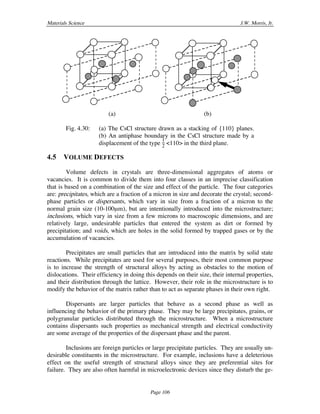This document discusses various types of defects that can occur in crystalline solids, including point defects, line defects (dislocations), two-dimensional defects (surfaces and interfaces), and volume defects. It focuses on point defects such as vacancies, interstitials, and solute/impurity atoms. Intrinsic point defects include vacancies and interstitials, while extrinsic defects are caused by solute/impurity atoms. These defects can have significant effects on properties like electrical conductivity in semiconductors and mechanical strength in structural alloys.
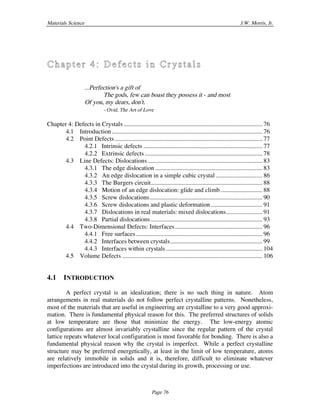

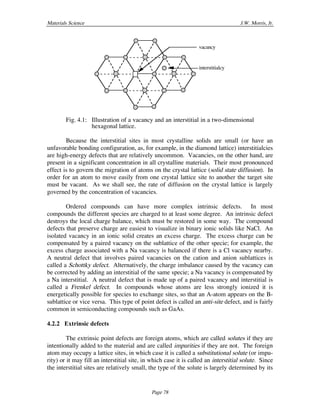








![Materials Science J.W. Morris, Jr.
Page 87
need in this course. Whenever we need to consider the crystallography of the dislocation
we shall assume that the crystal structure is simple cubic.
An edge dislocation in a simple cubic structure is drawn in Fig. 4.10, which
shows both a two-dimensional view and a three-dimensional section along the dislocation
line. The dislocation can be created by making a cut in the crystal on the dashed plane
that terminates at the dislocation line, displacing the material above the cut plane to the
left of the dislocation by one lattice spacing, and allowing the atoms to re-bond across the
slip plane. This recipe recreates the simple cubic unit cell everywhere except on the
dislocation line itself (ignoring the small elastic distortion of the cells that border the
dislocation line). Hence the Burgers vector, b, of the dislocation that is drawn in the
figure is b = a[100], where a is a vector along the edge of the cubic unit cell.
(a) (b)
Fig. 4.10: An edge dislocation in a simple cubic structure. The dotted
plane is the slip plane.
The process that creates the edge dislocation shown in Fig. 4.10 leaves one extra
vertical half-plane of atoms above the slip plane. This extra half-plane terminates at the
dislocation line, and is compressed there, as shown in the figure. The distortion at the
dislocation line is local. The simple cubic arrangement of atoms is essentially restored a
few atom spacings away from the dislocation line. The influence of the dislocation on
the atomic configuration rapidly decays into a small displacement that decreases in
magnitude with the inverse cube of the distance from the dislocation line. The local
distortion near the dislocation line (or dislocation core) is indicated in the figure.
In principle, the Burgers vector of a crystal dislocation can be any lattice vector;
for example, it is geometrically possible for an edge dislocation to be the termination of
any integral number of lattice planes. In reality, however, the Burgers vector is almost
invariably equal to the shortest lattice vector in the crystal. The reason is that the energy
per unit length of dislocation line, which is called the line energy, or, in a slightly
different context, the line tension of the dislocation, increases with the square of the
magnitude of b, |b|2. (While we shall not prove this, it is obvious from Fig. 4.10 that the
local distortion of the crystal would increase dramatically if two or more extra half-planes
terminated at the dislocation line.) Let the Burgers vector, b, be the vector sum of](https://image.slidesharecdn.com/defects-180928194202/85/Defects-12-320.jpg)


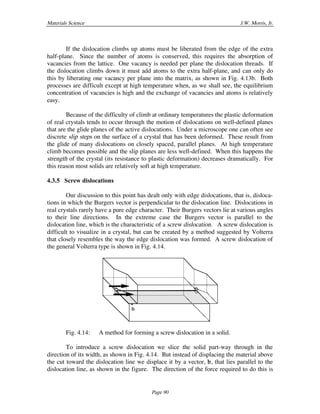
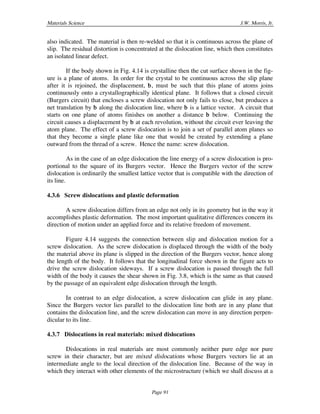

![Materials Science J.W. Morris, Jr.
Page 93
4.3.8 Partial dislocations
In the original concept of Volterra, the Burgers' vector of a crystal dislocation is a
translation vector of the crystal, that is, a vector that connects atom positions so that the
crystal can be rejoined perfectly across its glide plane. Such a dislocation is called a total
dislocation. The element of slip it induces carries an atom in the glide plane from one
atom position to another. Only total dislocations can be true two-dimensional defects. If
the Burgers' vector were not a translation vector of the crystal the slipped surfaces would
not weld perfectly together across the glide plane and a planar, surface defect would be
left behind whenever the dislocation moved.
While most crystal dislocations are total dislocations when viewed from suffi-
ciently far away, it is not uncommon to find them dissociated locally into a configuration
that can be described as two parallel partial dislocations connected by a planar defect that
is called a stacking fault in the crystal. The prototypic example is found in FCC crystals.
B
C
A
A A
AA
A A
B
B
C C
bb1
b2
b
b1
b2
A
A
A
A
A
A
B
B
B
B
B
B
...
Fig. 4.16: Illustration of the slip of close-packed planes. The dashed ar-
row shows slip by a total dislocation, b = 1
2 [–101], which car-
ries B“B. The solid arrows show the competing process of
successive slip by two partial dislocations. The shaded atom
in the cell is the intermediate, C-site position reached after
partial slip.
The common dislocation in the FCC structure is the dislocation that causes close-
packed planes to slip over one another. The close-packed planes are {111} planes, and
the Burgers' vectors of the dislocations that induce slip on these planes are the
1
2 <110>
vectors that connect atoms to their nearest neighbors in the {111} planes. Fig. 4.16 illus-
trates the path by which an FCC crystal is slipped by one atom spacing in the (111) plane.
The slip vector is
1
2 [–101], and is the slip caused by a dislocation with Burgers' vector b =
1
2 [–101]. Assuming that the glide plane of the dislocation lies between (111) planes of A
and B-type atom sites, the element of slip carries an atom from one B-site to another, as
shown in the figure. For clarity, the figure is drawn twice. The drawing on the left
shows the displacement in a stacking of close-packed planes (A,B). The drawing on the
right places the A and B planes in an FCC unit cell.](https://image.slidesharecdn.com/defects-180928194202/85/Defects-18-320.jpg)
![Materials Science J.W. Morris, Jr.
Page 94
Direct slip from one B position to another is relatively difficult, as one can easily
show by trying to slide two close-packed arrays of balls over one another. The atoms
(balls) in the B-plane must ride over the A atoms, as illustrated in the figure. It is much
easier to accomplish the slip in two sequential steps, as indicated in the figure, that cir-
cumvent the A atoms. The B atoms are first slipped into C positions, then moved from C
back to B again. The slip can be accomplished by the sequential passage of two disloca-
tions with the Burgers' vectors b1 and b2. However, b1 and b2 are not lattice vectors;
they are examples of partial dislocations. Their sum is the total dislocation, b.
B
B
BBB
B
A
CC
C
1/2[–1–12]
1/2[–211]
1/2[–101]
Fig. 4.17: Configuration of atoms in the (111) plane showing the partial
and total slip vectors.
To find the Burgers' vectors of the partial dislocations let the close-packed plane
be the (111) plane, as shown in the right-hand figure in 4.16. The atom shift is to the
shaded atom position, followed by a shift to the final atom position in the face center.
The (111) plane of B-sites in the unit cell in Fig. 4.16 is redrawn in Fig. 4.17. As shown
in this figure, the Burgers' vector of the total dislocation is b =
1
2 [–101]. The first partial
slip is from the B site at the corner of the unit cell to the nearest C-site in the plane. This
slip is 1/3 of the vector connecting B-sites along the height of the triangular configuration
of atoms in the plane, which is
1
2 [–1–12]. Hence
b1 =
1
6 [–1–12] 4.2
The second partial slip is from the C-site to the final B-site position. As shown in the fig-
ure, this vector is parallel to the vector
1
2 [–211}, and is 1/3 of its length. Hence
b2 =
1
6 [–211] 4.3
The vector sum of the two partial dislocation vectors is
b1 + b2 =
1
6 [–1–12] +
1
6 [–211] =
1
2 [–101] = b 4.4](https://image.slidesharecdn.com/defects-180928194202/85/Defects-19-320.jpg)

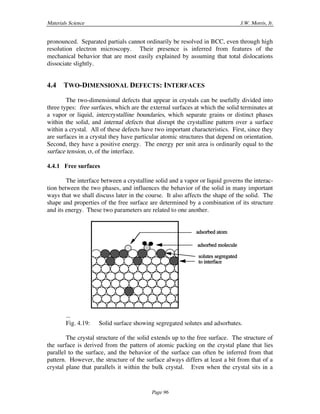





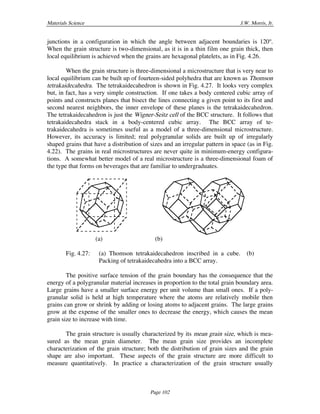

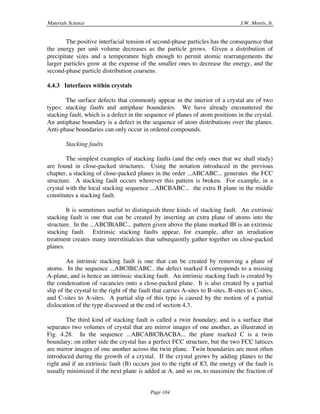
![Materials Science J.W. Morris, Jr.
Page 105
proper FCC packing in the crystal. The formation of twin boundaries is also important in
the plastic deformation of some materials, as we shall discuss later in the course.
...
Fig. 4.29: The relation of crystal planes across a twin boundary.
Note that if a stacking fault is repeated with perfect periodicity it does not
constitute a fault, but creates a new crystal structure. For example, the sequences
ABCAB, ABCABCAB, and ABABABC are regular mixtures of FCC and HCP packing
that generate new structures if they are repeated indefinitely. Such mixed structures
occur in nature. They are usually found in materials that exhibit both FCC and HCP-type
structures, which indicates that the stacking fault energy is relatively small. Mixed
structures are particularly common in SiC, ZnS and CdS, all of which have alternate å-
ZnS (FCC) and ∫-ZnS (HCP) structures. The mixed structures are called polytypes, and
can have very long repeat periods.
Antiphase boundaries
The internal defects known as antiphase boundaries only occur in ordered com-
pounds. An example is given in Fig. 4.30, which illustrates a {110} antiphase boundary
in a compound with the CsCl structure.
An ordered compound can always be regarded as a stacking of parallel planes,
each of which has a particular substitutional pattern of the atomic species. Fig. 4.30a, for
example, illustrates how the CsCl structure can be made by stacking {110} planes that
alternate in the specific arrangement of the two types of atoms. An antiphase boundary is
created when a plane with the wrong pattern appears, and subsequent planes follow it in
their patterns. In Fig. 4.29b the third {110} plane has its atom positions shifted by
1
2
<110> from the expected pattern, and is, hence, an antiphase defect. An antiphase
boundary resembles an intrinsic stacking fault in that it can be created either by omitting
one plane in the stacking pattern, or by a slip displacement at the antiphase plane.
Mechanical slip is an important source of antiphase defects. Note that the antiphase
defect in Fig. 4.30b is precisely that which would be created if a dislocation of Burgers
vector
1
2 [110] passed through the plane. Since
1
2 [110] is a vector connecting nearest
neighbor atoms in the closest-packed planes of the BCC structure, it is a common
Burgers vector for dislocations in BCC.](https://image.slidesharecdn.com/defects-180928194202/85/Defects-30-320.jpg)
